Eye Exams
Regular eye exams are one of the most important preventative measures for protecting your vision and health. Not only are you keeping your prescription up to date, but you are also receiving important diagnostic screenings that are a key part of maintaining eye health and preventing vision loss from common, treatable eye conditions.
To schedule your eye exam now, click here.
How much is an eye exam?
The cost of regular eye exams can vary significantly based on several factors including: location, your level of vision coverage, your chosen vision care provider and risk factors for certain common conditions. Wondering how much an exam might cost you? Call us today and we can discuss eye exam pricing for your specific situation.
You may also be interested in checking out our latest promotions!
Are eye exams covered by my insurance plan?
Depending on your insurance plan and your risk factors for certain eye conditions, many vision insurance plans provide one comprehensive eye examination per year. Insurance can often be confusing and, while we work with many common providers, you may want to contact us to discuss your particular situation.
How often should you get an eye exam?
Many factors can dictate how often you should get an eye exam including: age, risk factors for certain eye conditions, and your overall health. Based on your needs, you may only need an annual exam to renew your prescription or you might need more frequent exams to keep tabs on risk factors for an eye condition like glaucoma or cataracts. A good rule of thumb is for those over age 40, it is recommended to see your eye doctor once a year.
The American Optometric Association recommends the following examination guideline for early detection of visual problems in children and adults:
| Age | Recommended Eye Examination Frequency |
| Birth to 24 months | By 6 months of age or as recommended |
| 2 to 5 years | At 3 years of age |
| 5 to 19 years | Annually |
| 19 to 60 years | Every one to two years or as recommended |
| 61 and older | Annually or as recommended by your |
At Hardin Valley Eyecare & Optical, we see patients 3 and up. Request an appointment today!
What about these new online eye exams?
One of the services that has popped up in the past few years is online vision tests that then allow you to order prescription lenses to be delivered in the mail. While you may be tempted to consider this a more convenient option than visiting your local optometrist, you should first be aware of the limitations and potential risks of these online vision services.
Do I need a dilation eye exam?
In our office, we use only the best technology for a more thorough snapshot of your eye health during a comprehensive eye exam. We have the capability to capture images of your retina and monitor for eye diseases such as glaucoma, without a dilation eye exam or air puff.
Our machines capture high-quality images of your eye that let us see a picture of your overall health. With this technology we can detect eye disease before vision loss, and help manage varying eye conditions.
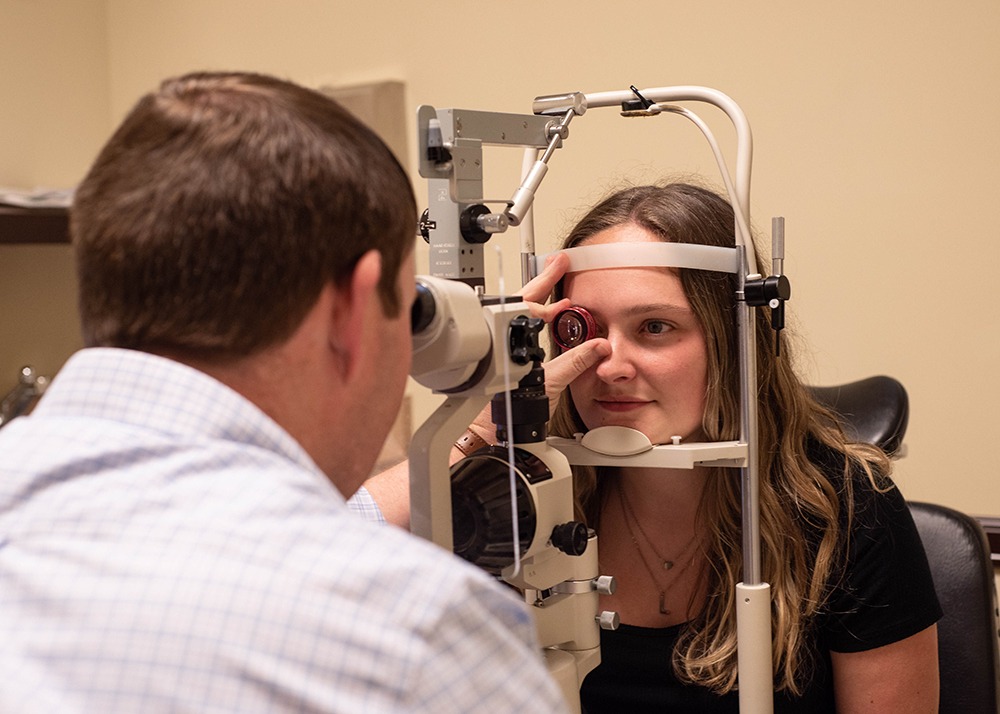
Should I schedule an eye exam now?
While getting new glasses or contacts is one of the more common motivations for scheduling an exam, you should schedule an exam now if you’ve experienced any of the following:
- Changes in vision
- Blurry or fuzzy vision
- Eye pain or strain
- Extreme or recurring headaches
- Seeing black or gray spots
- Seeing flashes of light
During the course of your eye exam, our vision care professionals will discuss any of these changes with you to help determine whether additional treatment is needed. While these symptoms may not turn out to be significant, they can often be indicators of serious vision problems that can prevent vision loss when caught and treated early enough.
What should I expect at my eye exam?
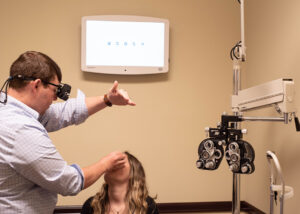 Plan to arrive 5 or 10 minutes early to your appointment and complete patient paperwork, handle insurance billing needs, and allow staff to prepare for your exam by reviewing your most recent prescription. During your exam, you will undergo a number of diagnostic screening procedures and answer a number of questions on your vision including:
Plan to arrive 5 or 10 minutes early to your appointment and complete patient paperwork, handle insurance billing needs, and allow staff to prepare for your exam by reviewing your most recent prescription. During your exam, you will undergo a number of diagnostic screening procedures and answer a number of questions on your vision including:
Dilation
Your eyes will be dilated with dilating drops that make your pupils larger and allow your eye doctor a better view of the internal structures of your eye during the comprehensive eye exam.
Note: When your pupils are dilated you will be more sensitive to light and may find it hard to focus on close-up objects; you should plan to bring sunglasses to your exam to help reduce glare and limit light sensitivity after your exam is complete.
Diabetes, Hypertension, and Other Risk Factors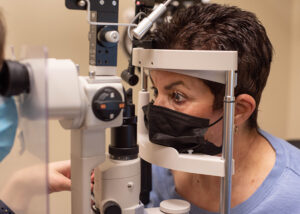 One of the most common vision problems is cataracts, which are one of the most common age-related vision issues. As patients reach 50-60 and older, their risk of developing cataracts increases drastically. Cataracts are a clouding of the lens inside the eye, causing the transparent lens to change to a yellow or brownish color, that typically leads to a decrease in visual clarity and difficulty with glare. An annual eye exam is the best way to diagnose and monitor cataracts until treatment is recommended.
One of the most common vision problems is cataracts, which are one of the most common age-related vision issues. As patients reach 50-60 and older, their risk of developing cataracts increases drastically. Cataracts are a clouding of the lens inside the eye, causing the transparent lens to change to a yellow or brownish color, that typically leads to a decrease in visual clarity and difficulty with glare. An annual eye exam is the best way to diagnose and monitor cataracts until treatment is recommended.
While it may not seem significant in the context of a vision exam, diabetes is the leading cause of blindness in the U.S. and it is important to discuss your diagnosis at your eye exam. While diabetic eye exams aren’t typically any different than regular eye exams, diabetes can drastically increase your risk factors for retinopathy, a loss of vision due to changes in the blood vessels of the retina. Your comprehensive eye exams are the best way for vision care professionals to diagnose and monitor retinal changes that can indicate the progression of the disease.
Another common visual malady is age-related macular degeneration, which is most commonly shortened to simply macular degeneration. Macular degeneration affects the central area of the retina (the macula) and is one of the leading causes of vision loss among older patients age 60 and older. An annual comprehensive eye exam is the best preventative measure for macular degeneration. Schedule your eye exam today!
Contact lens exam
If you wear or want to wear contact lenses, you’ll need a standard eye exam and a contact lens exam. The standard exam covers your overall eye health and vision correction needs, but the contact lens exam includes special procedures to measure the surface of your eyes and evaluate your tear production, which are necessary to ensure you are prescribed the best contacts for your needs. These additional tests may add additional costs to your exam.
Request your eye exam today!
Frequently Asked Questions
What’s the difference between lenses and frames from the eye doctor when I can simply pick up an inexpensive pair of reading glasses at the store?
Drugstore reading glasses are pretty ubiquitous and can be a decent solution for some people, but there are two great reasons to visit an eye doctor:
- Regular eye exams help eyecare professionals diagnose eye conditions, like glaucoma and diabetic retinopathy, in their early stages before permanent vision loss has occurred, which increases your treatment options.
- Drugstore reading glasses take a one-size-fits-all approach to fit, which means that for people who have astigmatism, a different prescription in each eye, or even just eyes that are closer together or farther apart than average pre-made reading glasses may cause eye strain and headaches.
A quick visit to the eye doctor will allow you to get an exam and look at great options for lenses and frames that are the right fit and the right look for you.
How do I find frames that fit me properly?
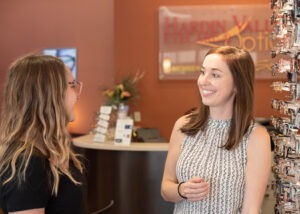 The easiest way to ensure you find a pair of glasses that fit properly is to be fitted by a professional and try the many options that are available at an optical shop with a large selection of high-quality frames. Just as with drugstore reading glasses, you may find many of the unisex options that are widely available at discount shops are only available in a single “one-size-fits-most” size. Fortunately, there are many eyewear companies now offering multiple sizes in their frames, which has greatly expanded the number of options available.
The easiest way to ensure you find a pair of glasses that fit properly is to be fitted by a professional and try the many options that are available at an optical shop with a large selection of high-quality frames. Just as with drugstore reading glasses, you may find many of the unisex options that are widely available at discount shops are only available in a single “one-size-fits-most” size. Fortunately, there are many eyewear companies now offering multiple sizes in their frames, which has greatly expanded the number of options available.
What about finding eyeglasses that look great on me?
Much like finding a proper fit, finding great looking eyeglasses is all about going to a place with many options. From there, you can get help deciding your face shape and determining which styles of frames go well with your shape as well as seeing how the various colors suit your eye color, hair color and skin tone.
I like my glasses, but how do I avoid annoying reflections?
Lenses with anti-reflective coating, or AR coating, help you see through your glasses more easily and let others see your eyes better by eliminating annoying glare, for example the white spots commonly seen in photos taken with a flash.
My lenses are very thick; is there anything I can do to reduce the thickness of my lenses?
Yes! Your thick lenses can typically be replaced with high-index lenses made of thinner and lighter materials. Aspheric lenses with indexes of 1.67 or higher can make your lenses make your eyeglasses lighter and more comfortable and reduce your lens thickness by half.
What about prescription sunglasses or those lenses that darken when you go outside?
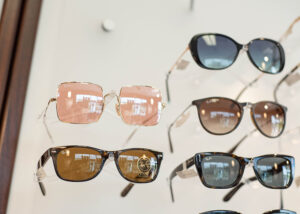 Photochromic lenses, which darken automatically when exposed to the sun’s UV rays, can be a great option for people who frequently transition between indoor and outdoor areas and don’t want to bother with switching between glasses and prescription sunglasses. When it comes to driving, we offer XTRActive transition lenses that darken inside of your car or truck! To ensure you’re getting the best protection, you still might want to purchase a pair of prescription sunglasses for driving.
Photochromic lenses, which darken automatically when exposed to the sun’s UV rays, can be a great option for people who frequently transition between indoor and outdoor areas and don’t want to bother with switching between glasses and prescription sunglasses. When it comes to driving, we offer XTRActive transition lenses that darken inside of your car or truck! To ensure you’re getting the best protection, you still might want to purchase a pair of prescription sunglasses for driving.
How can I keep my eyeglasses in great shape?
When buying frames, make sure you’re buying high-quality frames with spring hinges and adhere to the proper care instructions for your frames and lenses. You’ll likely want to avoid trendy frames that could go out of style quickly. Furthermore, you should have a scratch-resistant coating applied to the lenses. With proper care, high-quality frames in a classic style with scratch-resistant lenses will stay in great shape for a long time.
What about glasses for my child? How do I choose glasses that my child will actually wear? How do I keep them in good shape?
 When it comes to getting a child to wear their glasses, you have to make sure they actually want to wear the glasses. Typically the most important factor in getting a child to want to wear glasses is letting them pick out their frames. This allows them to choose frames that they like and feel are attractive rather than frames that were selected for them.
When it comes to getting a child to wear their glasses, you have to make sure they actually want to wear the glasses. Typically the most important factor in getting a child to want to wear glasses is letting them pick out their frames. This allows them to choose frames that they like and feel are attractive rather than frames that were selected for them.
If you’re worried about durability and keeping an active child’s glasses from breaking, consider materials that are scratch and impact resistant as well as frames with features like spring temples. Polycarbonate is a great option for children because it’s very impact-resistant. Additionally, if you have a child whose prescription changes often, you might consider buying new lenses and having them put in the old frames rather than buying new frames each time.

